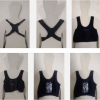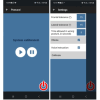Wearable Smartphone-Based Multisensory Feedback System for Torso Posture Correction: Iterative Design and Within-Subjects Study
- PMID: 39841997
- PMCID: PMC11809616
- DOI: 10.2196/55455
Wearable Smartphone-Based Multisensory Feedback System for Torso Posture Correction: Iterative Design and Within-Subjects Study
Abstract
Background: The prevalence of stroke is high in both males and females, and it rises with age. Stroke often leads to sensor and motor issues, such as hemiparesis affecting one side of the body. Poststroke patients require torso stabilization exercises, but maintaining proper posture can be challenging due to their condition.
Objective: Our goal was to develop the Postural SmartVest, an affordable wearable technology that leverages a smartphone's built-in accelerometer to monitor sagittal and frontal plane changes while providing visual, tactile, and auditory feedback to guide patients in achieving their best-at-the-time posture during rehabilitation.
Methods: To design the Postural SmartVest, we conducted brainstorming sessions, therapist interviews, gathered requirements, and developed the first prototype. We used this initial prototype in a feasibility study with individuals without hemiparesis (n=40, average age 28.4). They used the prototype during 1-hour seated sessions. Their feedback led to a second prototype, which we used in a pilot study with a poststroke patient. After adjustments and a kinematic assessment using the Vicon Gait Plug-in system, the third version became the Postural SmartVest. We assessed the Postural SmartVest in a within-subject experiment with poststroke patients (n=40, average age 57.1) and therapists (n=20, average age 31.3) during rehabilitation sessions. Participants engaged in daily activities, including walking and upper limb exercises, without and with app feedback.
Results: The Postural SmartVest comprises a modified off-the-shelf athletic lightweight compression tank top with a transparent pocket designed to hold a smartphone running a customizable Android app securely. This app continuously monitors sagittal and frontal plane changes using the built-in accelerometer sensor, providing multisensory feedback through audio, vibration, and color changes. Patients reported high ratings for weight, comfort, dimensions, effectiveness, ease of use, stability, durability, and ease of adjustment. Therapists noted a positive impact on rehabilitation sessions and expressed their willingness to recommend it. A 2-tailed t-test showed a significant difference (P<.001) between the number of the best-at-the-time posture positions patients could maintain in 2 stages, without feedback (mean 13.1, SD 7.12) and with feedback (mean 4.2, SD 3.97), demonstrating the effectiveness of the solution in improving posture awareness.
Conclusions: The Postural SmartVest aids therapists during poststroke rehabilitation sessions and assists patients in improving their posture during these sessions.
Keywords: digital health; digital intervention; digital technology; gerontology; mHealth; mobile health; multisensory feedback; postural balance; posture; smartphone; stroke; stroke rehabilitation; wearable technology.
©Amanda Polin Pereira, Olibario Jose Machado Neto, Valeria Meirelles Carril Elui, Maria da Graca Campos Pimentel. Originally published in JMIR Aging (https://aging.jmir.org), 22.01.2025.
Conflict of interest statement
Conflicts of Interest: None declared.
Figures









Similar articles
-
Quantitative Evaluation of Postural SmartVest's Multisensory Feedback for Affordable Smartphone-Based Post-Stroke Motor Rehabilitation.Int J Environ Res Public Health. 2025 Jun 28;22(7):1034. doi: 10.3390/ijerph22071034. Int J Environ Res Public Health. 2025. PMID: 40724102 Free PMC article.
-
Smartphone-Based Visual Feedback Trunk Control Training Using a Gyroscope and Mirroring Technology for Stroke Patients: Single-blinded, Randomized Clinical Trial of Efficacy and Feasibility.Am J Phys Med Rehabil. 2016 May;95(5):319-29. doi: 10.1097/PHM.0000000000000447. Am J Phys Med Rehabil. 2016. PMID: 26829087 Clinical Trial.
-
Trainer in a pocket - proof-of-concept of mobile, real-time, foot kinematics feedback for gait pattern normalization in individuals after stroke, incomplete spinal cord injury and elderly patients.J Neuroeng Rehabil. 2018 May 29;15(1):44. doi: 10.1186/s12984-018-0389-4. J Neuroeng Rehabil. 2018. PMID: 29843763 Free PMC article. Clinical Trial.
-
Effectiveness of Upper Limb Wearable Technology for Improving Activity and Participation in Adult Stroke Survivors: Systematic Review.J Med Internet Res. 2020 Jan 8;22(1):e15981. doi: 10.2196/15981. J Med Internet Res. 2020. PMID: 31913131 Free PMC article.
-
Gait post-stroke: Pathophysiology and rehabilitation strategies.Neurophysiol Clin. 2015 Nov;45(4-5):335-55. doi: 10.1016/j.neucli.2015.09.005. Epub 2015 Nov 4. Neurophysiol Clin. 2015. PMID: 26547547 Review.
Cited by
-
Quantitative Evaluation of Postural SmartVest's Multisensory Feedback for Affordable Smartphone-Based Post-Stroke Motor Rehabilitation.Int J Environ Res Public Health. 2025 Jun 28;22(7):1034. doi: 10.3390/ijerph22071034. Int J Environ Res Public Health. 2025. PMID: 40724102 Free PMC article.
References
-
- GBD 2019 Stroke Collaborators Global, regional, and national burden of stroke and its risk factors, 1990-2019: a systematic analysis for the Global Burden of Disease Study 2019. Lancet Neurol. 2021 Oct;20(10):795–820. doi: 10.1016/S1474-4422(21)00252-0. https://air.unimi.it/handle/2434/866438 S1474-4422(21)00252-0 - DOI - PMC - PubMed
-
- Rajati F, Rajati M, Rasulehvandi R, Kazeminia M. Prevalence of stroke in the elderly: a systematic review and meta-analysis. Interdiscip Neurosurg. 2023;32:101746. doi: 10.1016/j.inat.2023.101746.Elsevier - DOI
-
- Miranda M. Números do AVC. [2024-12-07]. https://avc.org.br/numeros-do-avc/
-
- Lin SH, Dionne TP. Interventions to improve movement and functional outcomes in adult stroke rehabilitation: review and evidence summary. J Particip Med. 2018;10(1):e3. doi: 10.2196/jopm.8929. https://jopm.jmir.org/2018/1/e3/ v10i1e3 - DOI - PMC - PubMed
MeSH terms
LinkOut - more resources
Full Text Sources
Medical

